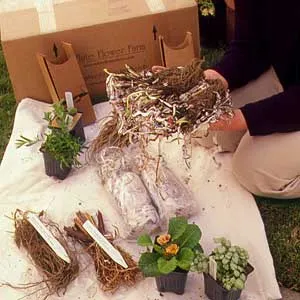
Nurseries commonly sell “bare-root” plants—dormant trees, shrubs, cane berries and, sometimes, perennials with the soil removed from their roots—in winter and early spring. Although these scraggly, lifeless-looking sticks lack the shelf appeal of container plants, several factors make them a much better buy:
•Bare-root plants cost 15-25 percent less than container plants. Although that might not amount to much on a single tree, it adds up when you’re buying many plants for a backyard orchard or a new hedge.
•Since bare-root plants take up less space than container plants, nurseries, can offer more varieties. And, they will often special-order plants you can’t find.
•Without the bulk and weight of soil, bare-root trees and shrubs are easier to fit into your car, lift and maneuver. This also makes for lower shipping weight if you’re shopping by catalog or on the Web.
•Bare-root plants often adapt more easily to garden soil, since they don’t have to make the transition from the artificial soil mix in nursery containers. They also develop strong roots. And unlike container plants, which can arrive with their roots cramped and overgrown, bare roots are free to spread out through soil.
•Shop early while plants are fresh, before they start to leaf out. And, especially when buying bare-root trees, buy big. Larger ones will fruit, flower or cast shade sooner. Full-service nurseries are where you’re most likely to find them.
•Also look for plants displayed with the roots sunk into moist sand or sawdust, which keeps them from drying out. Then examine the roots; they should be plump and well-developed. Finally, avoid bare-root trees whose roots are wrapped in plastic bags. These are a risky buy, since roots must be severely pruned to fit inside.
